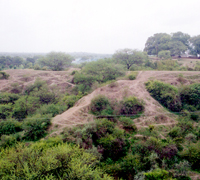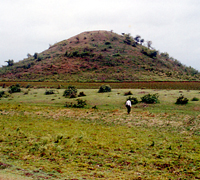Bhairogarh
| Author:Laxman Burdak, IFS (R) |

Bhairogarh (भैरोगढ़) is a village in tahasil and district Ujjain in Madhya Pradesh, India.
Location
It is located 3 km north of Ujjain. Pincode of Bhairawgarh Ujjain is 456010
Variants
- Bhairongarha भैरोंगढ़, जिला उज्जैन, म.प्र., (AS, p.678)
- Bhairavgarh (भैरवगढ़)
- Bhairawgarh (भैरवगढ़)
Jat clans
- Bheron (भेरों) - This gotra is said to be started from their ancestral Nagavanshi King named Bhairava/Bhairav (भैरव). [1]
History

Bhairogarh is main site of ancient Ujjain, containing the remains of structures which are dated to 3rd -2nd Century B.C.[2]
Vaishya Tekri: This site at Undasa is a part of ancient Ujjain. Structural remains of Mauryan period have been found. Stupas are the conspicuous evidence of ancient habitation. [3]
Kumhar Tekri: Paleo-Pathology of Ancient Skeletal Remains - Dr. Veena Mushrif-Tripathy (2008), Visiting Fellow of the Anthropological Survey of India has submitted her year long work in the An.S.I. in the form of a report entitled ‘Human skeletal remains from the sites of Sarai Nahar Rai (Mesolithic) and Kumhar Tekri (Early Historic)’. In the report, she made a strong case for a ‘National Facility for Human Skeletal Research’, a centre for research comprising the skeletal repository with in the Anthropological Survey of India.[4]
Kal Bhairava temple
Kal Bhairava temple: The worship of the eight Bhairavas is a part of Saivite tradition, and the chief among them is Kala Bhairava. The Kal Bhairava temple is believed to have been built by King Bhadrasen, on the banks of the Shipra. Mentioned in the Avanti Khanda of the Skanda Purana. Important for the Tantric Kapalika and Aghora sects, of which Ujjain was a prominent centre. Beautiful paintings in the Malwa style once decorated the temple walls, only traces of which are visible. The village of Bhairogarh, famous for its printing, takes its name from the temple, and is located very near.
Siddhavat: Features an enormous banyan tree on the banks of the Shipra, considered sacred since the medieval ages. This banyan tree has got the same significance as that of akshayavata in Prayag and Gaya, Vanshivata of Vrindavan and Panchavata of Nasik.
Thousands of people take dip in the Shipra River from the bathing ghats built here. According to one tradition, Parvati is believed have performed her penance here. It used to be a place of worship for the followers of the Natha sect.
Bhairogarh: The little village of Bhairogarh near Siddhawat is famous for its tie-and-die printing for centuries. In ancient times, when the trade with other counties flourished, exquisitely printed cloth from Bhairogarh used to find its way to Rome and China.
भैरोंगढ़, उज्जैन
भैरोंगढ़ (AS, p.678) जिला उज्जैन, मध्य प्रदेश में उज्जैन से एक मील उत्तर की ओर स्थित है. भैरोगढ़ में दूसरी-तीसरी शती ई. पू. की उज्जयिनी के खंडहर पाए गए हैं. यहाँ 'वेश्या-टेकरी' (Vaishya Tekri) और 'कुम्हार-टेकरी' (Kumhar-Tekari) नाम के टीले हैं, जिनको खोदने से तत्कालीन उज्जयिनी के अनेक अवशेष मिले हैं. इन टीलों से कई प्राचीन किंवदंतियों का सम्बन्ध बताया जाता है. [5]
वेैश्य टेकरी (बौद्ध स्तूप) उज्जैन मध्यप्रदेश
उज्जैेन शहर से लगभग 5-6 किलो मीटर दूरी पर उज्जैन से मक्सी रोड पर ग्राम कानीपुरा के पास स्थित पीलिया खाल नाले पर दो बौद्ध स्तूप स्थित हैं। जिनकी ऊचाई 100 और ब्यास लगभग 350 फीट है। बौद्ध स्तूप मौर्यकाल के पूर्व के हैं उपरोक्त बौद्ध स्तूपों के समूह को वर्तमान में वेश्या टेकरी के नाम से जाना जाता है। सम्राट अशोक की पत्नि वैश्य पुत्री देवी ने उज्जैन में उक्त बौद्ध स्तूपों को बनवाया था। इसलिए वर्तमान में स्तूप समूह को वेश्या टेकरी के नाम से जाना जाता है। सम्राट अशोक के समय इन्हीं स्तूपों को जीर्णोधार हुआ था क्योंकि यहां से प्राग मौर्य एवं मौर्यकालीन दोनेां प्रकार की ईटें मिलती हैं। उत्खनन के दौरान इन स्तूपों में बौद्ध भिक्षुओं के शरीर के अवशेष प्राप्त हुये हैं। बौद्ध स्तूपों का निर्माण मिट्टी से बनाई गई ईटों से किया गया है वर्तमान में भारतीय पुरातत्व विभाग द्वारा वेश्या टेकरी स्तूपों को संरक्षित घोषित किया गया है। परन्तु स्तूपों से लगी जमीन में संबंधित किसानों द्वारा खेती की जाती है और संबंधित स्तूपों से लगी जमीन से किसानों द्वारा स्तूपों को क्षतिग्रस्त किया जाकर और उनकी मिट्टी तथा ईट को निकालकर स्तूपेां की जमीन को खेती की जमीन में सम्मिलित किया जा रहा है। मौके पर स्तूपेां को संरक्षण के लिए कोई फेंसिंग की ब्यवस्था नहीं है। अतः मौके पर स्तूपेां का संरक्षण अतिआवश्यक है जिसके लिए फेंसिंग लगाया जाना और स्तूपेां के आसपास की जमीन को संरक्षित किया जाना भी आवश्यक है।[6]
कुम्हार-टेकरी
वेश्या टेकरी के पूर्ब की ओर लगभग 1 किलोमीटर की दूरी पर स्थित कुम्हार-टेकरी नामक एक अन्य टीला था. यह टीला 220 फीट लंबा 110 फीट चौड़ा और 15 फीट ऊंचा था. इस टीले से अधिक संख्या में मृड-भांड प्राप्त होने के कारण इसे कुम्हार-टेकरी के नाम से पुकारा जाता था. 1938-39 में इसका भी उत्खनन कराया गया था जिससे यह ज्ञात हुआ कि यह एक श्मशान भूमि थी. यहां उत्खनन में प्राप्त मुद्राओं से स्पष्ट हो गया कि यह टीला ई.पूर्व दूसरी शताब्दी के पूर्व का था. उत्खनन काल में टीले की ऊपरी सतह से केवल दो-तीन फुट की गहराई से कंकाल प्राप्त हुए जिनकी संख्या कुल 42 थी. इनमें से 18 कंकाल की जांच, निरीक्षण तथा अध्ययन के लिए भारतीय मानव शास्त्रीय सर्वेक्षण विभाग द्वारा कोलकाता ले जाया गया. उनके अभिवेदन के अनुसार इन कंकालों से संबंधित लोगों को इंडो-आर्यन जाति का माना जा सकता है.[7]
External links
References
- ↑ Mahendra Singh Arya et al: Adhunik Jat Itihas, p. 273
- ↑ asibhopal.nic.in
- ↑ asibhopal.nic.in
- ↑ https://ansi.gov.in/paleo-anthropology/
- ↑ Aitihasik Sthanavali by Vijayendra Kumar Mathur, p.678
- ↑ http://yogeshmp.blogspot.com/2015/07/blog-post_27.html
- ↑ डॉ शादाब अहमद सिद्दीकी: 'मध्य प्रदेश संपूर्ण अध्ययन', Madhya Pradesh Sampurna Adhyayan (With Latest Facts and Data), p.367

